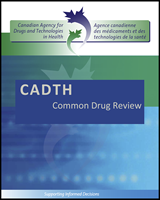Diabetes is a chronic metabolic disease with significant health impacts on individuals and societies. The prevalence of diabetes in Canada was 6.8% (2.4 million Canadians) in 2009 and is expected to rise to 3.7 million people by 2019. Ninety per cent of people with diabetes have type 2 diabetes mellitus, which is characterized by increased hepatic glucose output, reduced insulin secretion, and insulin resistance. People with diabetes are at risk of microvascular complications such as diabetic nephropathy and retinopathy, macrovascular complications such as cardiovascular disease, and premature mortality. Improved glycemic control reduces the risk of microvascular complications and possibly of macrovascular complications. Current guideline recommendations specify a target for glycated hemoglobin (A1C) of 7% or less for most patients with type 2 diabetes.
There are currently 11 classes of antihyperglycemic drugs approved for use in Canada for type 2 diabetes: metformin, sulfonylureas, meglitinides, alpha-glucosidase inhibitors, thiazolidinediones, dipeptidyl peptidase-4 (DPP-4) inhibitors, glucagon-like peptide-1 analogues, sodium-glucose cotransporter-2 inhibitors, basal insulins, bolus insulins, and biphasic insulins. Alogliptin is the fourth DPP-4 inhibitor to be introduced in Canada after sitagliptin, saxagliptin, and linagliptin. Upon submission, the manufacturer requested listing of alogliptin in a manner similar to other DPP-4 inhibitors in Canada. Based on consideration of listing criteria across Canada for existing DPP-4 inhibitors, and in consultation with the manufacturer, the following two of the six approved indications for alogliptin were reviewed by the CADTH Common Drug Review (CDR):
in combination with metformin when diet and exercise plus metformin alone do not provide adequate glycemic control
in combination with a sulfonylurea when diet and exercise plus a sulfonylurea alone do not provide adequate glycemic control.
Upon review of the draft CDR clinical and pharmacoeconomic reports, the manufacturer asked that the requested listing criteria be modified to reflect the two indications under review.
Of note, the Canadian Drug Expert Committee recommendations for the existing DPP-4 inhibitors have recommended listing for patients with inadequate glycemic control on metformin and a sulfonylurea who are unable to use insulin. However, alogliptin is not approved for use in combination with metformin and a sulfonylurea.
This report was prepared by the Canadian Agency for Drugs and Technologies in Health (CADTH). Through the CADTH Common Drug Review (CDR) process, CADTH undertakes reviews of drug submissions, resubmissions, and requests for advice, and provides formulary listing recommendations to all Canadian publicly funded federal, provincial, and territorial drug plans, with the exception of Quebec.
The report contains an evidence-based clinical and/or pharmacoeconomic drug review, based on published and unpublished material, including manufacturer submissions; studies identified through independent, systematic literature searches; and patient-group submissions. In accordance with CDR Update — Issue 87, manufacturers may request that confidential information be redacted from the CDR Clinical and Pharmacoeconomic Review Reports.
The information in this report is intended to help Canadian health care decision-makers, health care professionals, health systems leaders, and policy-makers make well-informed decisions and thereby improve the quality of health care services. The information in this report should not be used as a substitute for the application of clinical judgment with respect to the care of a particular patient or other professional judgment in any decision-making process, nor is it intended to replace professional medical advice. While CADTH has taken care in the preparation of this document to ensure that its contents are accurate, complete, and up-to-date as of the date of publication, CADTH does not make any guarantee to that effect. CADTH is not responsible for the quality, currency, propriety, accuracy, or reasonableness of any statements, information, or conclusions contained in the source documentation. CADTH is not responsible for any errors or omissions or injury, loss, or damage arising from or relating to the use (or misuse) of any information, statements, or conclusions contained in or implied by the information in this document or in any of the source documentation.
This document is intended for use in the context of the Canadian health care system. Other health care systems are different; the issues and information related to the subject matter of this document may be different in other jurisdictions and, if used outside of Canada, it is at the user’s risk. This disclaimer and any questions or matters of any nature arising from or relating to the content or use (or misuse) of this document will be governed by and interpreted in accordance with the laws of the Province of Ontario and the laws of Canada applicable therein, and all proceedings shall be subject to the exclusive jurisdiction of the courts of the Province of Ontario, Canada.
CADTH takes sole responsibility for the final form and content of this document, subject to the limitations noted above. The statements and conclusions in this document are those of CADTH and not of its advisory committees and reviewers. The statements, conclusions, and views expressed herein do not necessarily represent the views of Health Canada or any Canadian provincial or territorial government. Production of this document is made possible by financial contributions from Health Canada and the governments of Alberta, British Columbia, Manitoba, New Brunswick, Newfoundland and Labrador, Northwest Territories, Nova Scotia, Nunavut, Ontario, Prince Edward Island, Saskatchewan, and Yukon.

